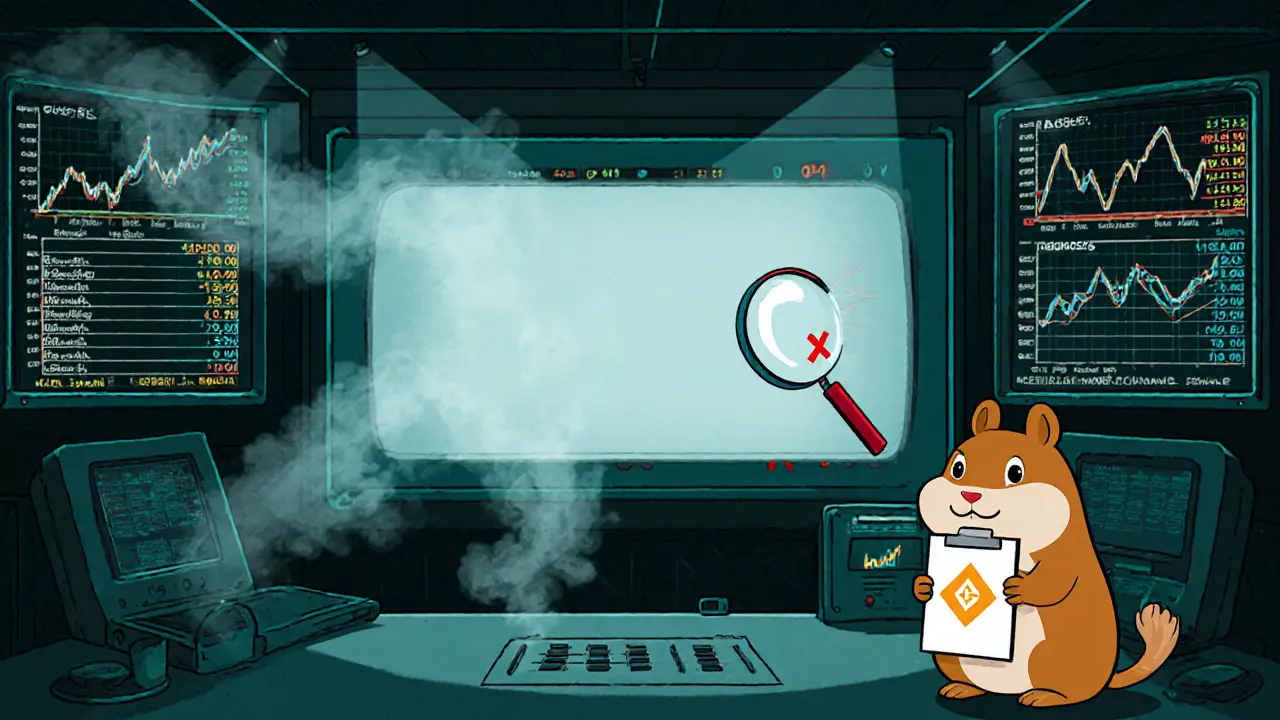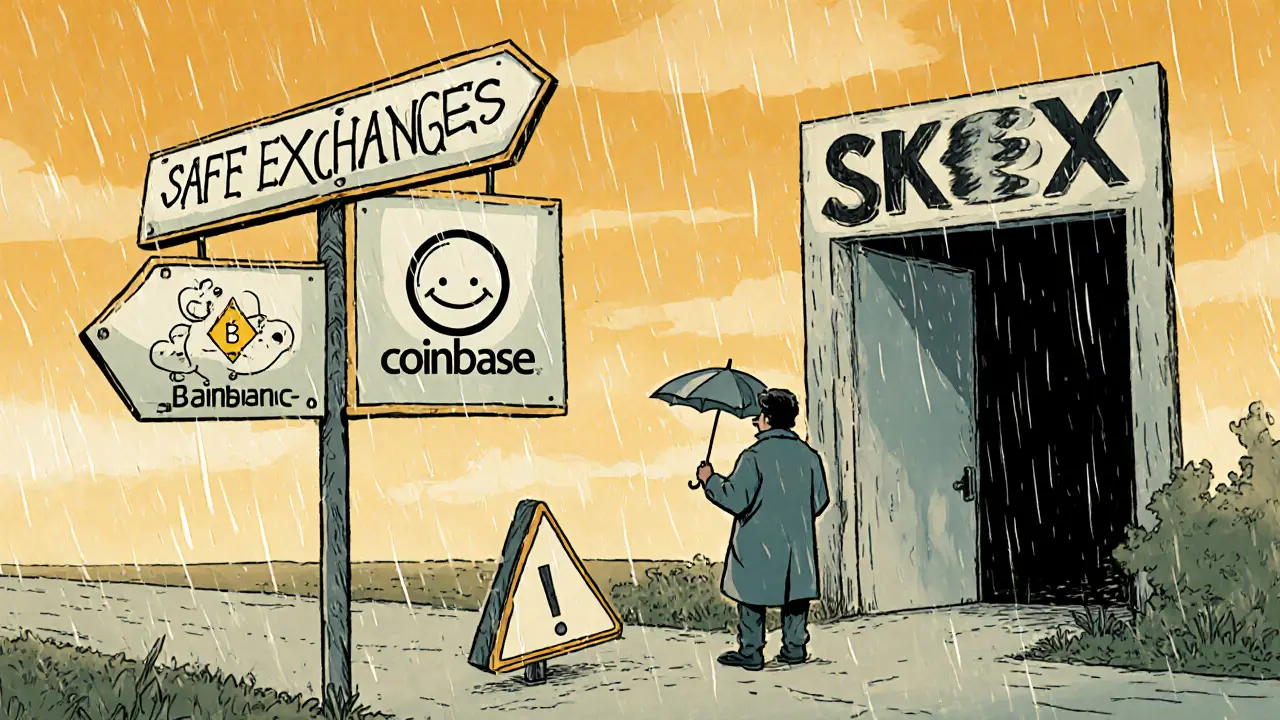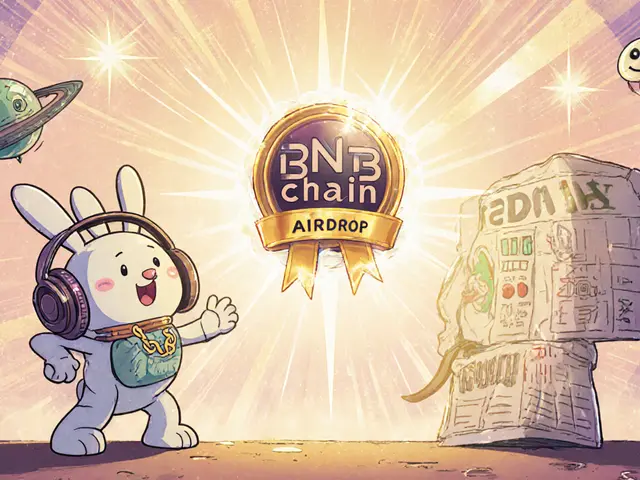
SKEX Exchange Risk Assessment Tool
SKEX is a Singapore-based centralized cryptocurrency exchange launched in September 2019. This tool helps you assess the key risks associated with trading on SKEX by evaluating critical factors such as transparency, regulation, security, and community sentiment.
Transparency Issues
SKEX does not publish trading volume or proof-of-reserves data, making it hard to verify actual market activity or asset backing.
High RiskRegulatory Uncertainty
No public record of a Major Payment Institution (MPI) licence from MAS, operating in a regulatory gray area.
High RiskSecurity Concerns
Lack of disclosure regarding cold-storage percentages, multi-sig wallets, and third-party audits raises security doubts.
Medium RiskCommunity Presence
Minimal user feedback on forums indicates low adoption or possible suppression of negative reviews.
Medium Risk| Feature | SKEX | Binance | Coinbase | Kraken |
|---|---|---|---|---|
| 24-hr Volume (USD) | Not disclosed | $72B | $12.5B | $4.3B |
| Proof-of-reserves | None published | Quarterly audit | Monthly audit | Quarterly audit |
| Regulatory Licence | Unverified (no MAS MPI) | Multiple global licences | US Money-Transmitter licence | US & EU licences |
| Security (Cold Storage %) | Unknown | 98% | 95% | 97% |
Based on the key factors evaluated, SKEX presents several significant risks:
- Liquidity Risk: No published volume makes it impossible to assess slippage or order-book depth.
- Regulatory Risk: No MAS MPI licence exposes users to potential legal uncertainty.
- Security Risk: Missing security disclosures increase vulnerability to theft or fraud.
- Reputation Risk: Near-zero community presence suggests limited user trust or possible exit scams.
- Verify the exchange’s licence on the MAS website before depositing any funds.
- Look for third-party audits or proof-of-reserves screenshots; if none exist, walk away.
- Compare fees and withdrawal speeds with a known exchange (e.g., Binance or Coinbase) to gauge hidden costs.
- Start with a tiny test deposit (no more than $50) and monitor trade execution and support response times.
- Keep an eye on community forums; a surge in user complaints is often the first sign of trouble.
When you hear the name SKEX is a Singapore‑based centralized cryptocurrency exchange launched in September 2019, you probably wonder whether it belongs in your trading toolkit. The short answer: most red flags outweigh the few positives, especially if you value transparent trading data, solid regulation, and proven security. This review walks you through everything you can verify about SKEX, compares it with the market’s heavyweights, and tells you exactly what risks you’d be signing up for.
What SKEX Claims to Offer
Officially, SKEX says it supports spot trading for a handful of major crypto assets and offers a web‑based interface for both retail and institutional users. The platform’s website lists a native token called SKX, but provides no public roadmap, fee schedule, or API documentation. Unlike rivals that publish detailed technical specs, SKEX’s public pages are sparse, leaving potential traders to guess about deposit limits, withdrawal speeds, and KYC requirements.
Transparency Gaps: Volume and Reserve Data
Most reputable exchanges publish real‑time 24‑hour trading volume and proof‑of‑reserves metrics. SKEX, however, shows no volume or reserve data on its dashboard or on third‑party aggregators like CoinMarketCap. The absence of verifiable volume is a classic warning sign: without it, you can’t tell if the order book reflects real market activity or is simply fabricated for the sake of appearance.
Regulatory Standing
Operating out of Singapore means SKEX falls under the jurisdiction of the Monetary Authority of Singapore (MAS). Since 2020, MAS requires any crypto exchange serving Singapore residents to obtain a Major Payment Institution (MPI) licence. No public filing or licence number for SKEX exists, and the exchange does not appear on MAS’s approved list. By contrast, competitors such as Crypto.com and Independent Reserve openly display their licences, reinforcing user confidence.

Security Measures (or Lack Thereof)
Top exchanges routinely disclose cold‑storage percentages, multi‑sig wallet usage, and third‑party audit results. SKEX provides none of these details. Independent security reports from CoinDesk note that exchanges without published security frameworks often fall into two categories: nascent platforms still building infrastructure, or “ghost” exchanges used for wash‑trading and market manipulation. Given SKEX’s four‑year history, the former explanation seems unlikely.
Community Sentiment and User Feedback
Platforms like Trustpilot, Reddit’s r/CryptoCurrency, and Bitcointalk host thousands of exchange reviews. A search for “SKEX” returns virtually no posts, complaints, or praise. Compare that with Binance (over 12,000 Trustpilot reviews) or Kraken (3,800 reviews). The silence suggests either extremely low adoption or an effort to keep the user base hidden.
How SKEX Stacks Up Against the Leaders
| Feature | SKEX | Binance | Coinbase | Kraken |
|---|---|---|---|---|
| 24‑hr volume (USD) | Not disclosed | $72B | $12.5B | $4.3B |
| Proof‑of‑reserves | None published | Quarterly audit | Monthly audit | Quarterly audit |
| Regulatory licence | Unverified (no MAS MPI) | Multiple global licences | US Money‑Transmitter licence | US & EU licences |
| Customer support | Undocumented | 24/7 live chat | Phone & chat (≤2h response) | Live chat & email |
| Security (cold storage %) | Unknown | 98% | 95% | 97% |
Practical Aspects: Onboarding, Fees, and Trading Experience
Since SKEX’s KYC flow isn’t publicly described, we can’t confirm how many documents are required or how long verification takes. Competitors usually finish basic verification within 24hours, with advanced tiers taking up to 72hours. Fee information is also missing; the industry standard is a 0.1% maker/taker fee for spot trades, with discounts for high‑volume traders. Without a transparent fee schedule, you risk paying hidden spreads or withdrawal penalties.

Risk Summary
- Liquidity risk: No published volume makes it impossible to gauge slippage or order‑book depth.
- Regulatory risk: No evidence of MAS MPI licence puts you at the mercy of a potentially unregulated entity.
- Security risk: Absence of cold‑storage details or third‑party audits leaves assets vulnerable.
- Reputation risk: Near‑zero community presence suggests limited user base and possible exit scams.
Bottom Line: Should You Trade on SKEX?
If you prioritize safety, transparent trading data, and regulatory compliance, SKEX falls short on almost every front. The platform might be trying to rebuild, but without visible improvements-published volume, proof of reserves, or a clear licensing status-the safest move is to stick with established exchanges that openly share these metrics. In short, treat SKEX as a high‑risk option and only allocate funds you can afford to lose.
Next Steps for Cautious Traders
- Verify the exchange’s licence on the MAS website before depositing any funds.
- Look for third‑party audits or proof‑of‑reserves screenshots; if none exist, walk away.
- Compare fees and withdrawal speeds with a known exchange (e.g., Binance or Coinbase) to gauge hidden costs.
- Start with a tiny test deposit (no more than $50) and monitor trade execution and support response times.
- Keep an eye on community forums; a surge in user complaints is often the first sign of trouble.
Frequently Asked Questions
Is SKEX regulated in Singapore?
There is no public record of SKEX holding a Major Payment Institution licence from the Monetary Authority of Singapore. Without that licence, the exchange operates in a regulatory gray area.
Can I see SKEX’s trading volume?
No. SKEX does not publish real‑time volume data on its site, and major aggregators like CoinMarketCap list it without a volume figure. This makes it impossible to assess liquidity.
What security measures does SKEX use?
SKEX does not disclose cold‑storage ratios, multi‑sig wallet usage, or audit reports. Until such details are released, the security posture remains unknown.
How does SKEX’s customer support compare to other exchanges?
Support channels are undocumented. Established exchanges typically respond within two hours via live chat; SKEX offers no clear contact method, suggesting slower or nonexistent assistance.
Is there any community feedback on SKEX?
Searches on Trustpilot, Reddit, and Bitcointalk turn up virtually no discussions. A lack of user reviews often points to low adoption or deliberate suppression of feedback.





Comments (17)
Dick Lane
Been using SKEX for a few months and honestly I'm surprised it's still up. No volume data, no audits, no clear support channels. I deposited $200 last month just to test and the withdrawal took 11 days. No updates, no emails, just silence. Now I'm waiting for my money to disappear like everyone else.
Serena Dean
Don't risk it. I used to trade on sketchy platforms back in 2017 and lost everything. If an exchange doesn't show proof of reserves or a license, it's not worth your time. Stick with Coinbase or Kraken - they might be pricier but at least you won't wake up to a blank dashboard.
James Young
This review is too soft. SKEX isn't just risky - it's a full-blown scam. No MAS license? No volume? No security disclosures? That's not negligence, that's intentional fraud. Anyone who deposits money here is either stupid or already got scammed once before. Stop giving these guys the benefit of the doubt.
Chloe Jobson
Regulatory gray zones in crypto are dangerous. MAS requires MPI licensing for a reason - to protect retail users. SKEX operating without it isn't just non-compliant, it's predatory. If you're considering them, you're already in the high-risk bucket. Walk away.
Andrew Morgan
I remember when Binance was just a forum post with a Telegram group. But even back then they had volume, they had transparency, they had community. SKEX? Nothing. Zero. Zip. That silence screams louder than any red flag. Don't get sucked in by the 'new platform' hype. Real projects don't hide.
Michael Folorunsho
Singapore is supposed to be a financial hub. How is this even allowed? I'm from the US and even our worst exchanges have at least a Money Transmitter license. This SKEX thing is a joke. If you're not in Singapore, why are you even looking at this? Stick to regulated platforms. End of story.
Roxanne Maxwell
I read this whole thing and felt so relieved I never signed up. I've had friends lose everything on platforms that looked 'promising' but had no transparency. Please, if you're new to crypto - start with something that's been around and actually talks to its users. You'll thank yourself later.
Jonathan Tanguay
People keep saying 'trust but verify' but SKEX doesn't even give you the tools to verify. No API docs? No fee schedule? No KYC info? That's not 'new startup vibes' that's criminal negligence. I checked MAS registry myself - zero results. The fact that people still consider this is why crypto is full of scams. You think you're being smart by finding 'hidden gems' but you're just feeding the wolves.
Ayanda Ndoni
Bro I tried SKEX last year, deposited 0.5 BTC, never got it back. Called their 'support' - no reply. Tried Reddit, no posts. Tried emailing - bounced. Now I'm just waiting for the whole thing to vanish. Honestly I don't even care anymore. I just hope someone else doesn't fall for it.
Elliott Algarin
It's funny how we all rush to judge platforms like this. But maybe SKEX is just too small to matter. Maybe they're building quietly. Maybe they're waiting for the right moment. Or maybe they're just gone already. Either way, the lesson isn't about SKEX - it's about how we assign meaning to silence.
John Murphy
Why does no one ever mention the wallet addresses? If they're not showing volume, maybe they're not even moving coins. I checked the blockchain for SKX token transfers - almost nothing since launch. That's not a trading platform, that's a ghost town with a website.
Zach Crandall
As a Canadian trader, I find it alarming that users from other jurisdictions even consider platforms with zero regulatory oversight. This is not a matter of preference - it is a legal and financial liability. If your funds are not protected by jurisdictional safeguards, they are not yours.
Akinyemi Akindele Winner
SKEX? More like SKEX-IT. Burn it with fire. This ain't some startup - it's a digital vampire sucking the life out of gullible traders. If you're dumb enough to put money in there, you deserve to lose it. But please, don't drag the rest of us down with your bad decisions.
Patrick De Leon
Let me be clear - this isn't about trust. This is about legality. No MAS license = illegal operation. End of discussion. Anyone using SKEX is participating in an unregulated financial activity. That's not investing - that's gambling with zero legal recourse.
madhu belavadi
Same. I lost $1500 here. No one responds. No refunds. No explanations. Just silence. I thought I was being clever finding a new exchange. Turns out I was just the next victim.
MANGESH NEEL
Everyone's acting like this is some shocking revelation. Newsflash - 90% of crypto exchanges are scams. SKEX is just the latest one with a decent-looking website. The real problem? You people keep falling for the same tricks. You want transparency? You want security? Then stop chasing 'low fees' and 'new tokens' and stick to the giants. You think you're saving money? You're just losing it slower.
Norman Woo
what if skex is a honeypot set up by the feds to catch money launderers? i mean think about it - no volume, no license, no support - sounds like a trap. maybe they're just waiting for enough dumb people to deposit to trace the flow. i mean who even runs a crypto exchange like this? someone with a grudge?